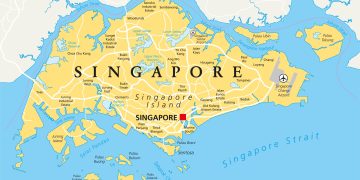–
Although niche in some ways, commingling is an interesting subject and does go to the heart of what we do at P&I Clubs but it doesn’t receive the coverage it should. We are not talking about the legal term which refers to a financial situation but we are talking about the mixing of bulk oil cargoes in a tanker. Actually, we are talking about multiple parcels of same spec cargo being loaded from different suppliers into the same hold or tank without segregation. The intention is to deliver that cargo to many receivers under several bills of lading. The cargo from the same supplier even if loaded from separate sources ashore is not commingling. The carrier simply carries and delivers the cargo
The other method for mixing cargo is “blending” which refers to the process of loading parcels of cargo with different specifications but originating from the same supplier and loading into the same cargo space. Therefore, these parcels are mixed on board. The objective is to produce a cargo that is different in specification from any of the parcels it comprises. Blending could be for creating a new cargo, dying, doping with additives for a specific purpose. Strictly speaking, blending is done ashore to produce a pre-defined product from different constituent parts. But in reality it is often done by taking x tonnes from one shore tank, y tonnes from another shore tank and z tonnes from a different shore tank and blending them in the loading pipeline. This approach does not guarantee a uniform blend of product on the vessel
In May 2012, SOLAS amendments included amendment to SOLAS Chapter VI on “Carriage of Cargoes and Oil Fuels” to add a new regulation VI/5-2 which came into force on 1st Jan this year. The Regulation prohibits the blending of bulk liquid cargoes during the sea voyage and specifically prohibits production processes on board ships.
Increasingly, the practice of mixing cargo was discouraged on the open sea. The 2011 “Guidelines for the Carriage of Blends of Petroleum Oil and Biofuels” (published in advance of the SOLAS amendment) specifies that mixing operations should only be undertaken whilst the ship is within port limits. Each port state and/or port authority defines where and in what circumstances blending can legitimately occur in their area. Permission and guidance should be obtained from the Port Authority in advance. You may find, for example, that blending at an anchorage of a port en route may not be permissible if there are no facilities there for spill response even if blending within that port is generally allowed. So, local port authorities should be consulted before undertaking the operation. Operators will also find that they have to check with their Flag State to ensure that the blending operation is allowed (according to ship type, configuration etc). We see quite a few queries too. Understandably, members are looking to establish if the proposed operation at the specified location will be covered.
Nowadays, where it is permitted blending/co-mingling in port occurs fairly regularly and, whilst not permitted everywhere at all times, it is a widespread operation. Many traders and/or charterers manage to get round the restriction on the open sea by undertaking STS operations, of course. It goes without saying that all movements of oil cargoes should be recorded in the Oil Record Book in order to comply with MARPOL. Pollution is one of the areas the blending provisions are intended to address. Essentially, if you’re moving oil around a ship, at sea, there is a real chance of overflow and pollution. Regulators have therefore decided to restrict the practice to avoid scenes like this and the economic nightmare they involve.
Ships treat blending and co-mingling as being one and the same – so whether we are talking about taking X tonnes from one shore tank, Y tonnes from another shore tank and Z tonnes from a different shore tank and blending them in the loading pipeline OR putting additives or dye into the cargo OR mixing whole tanks of cargo on the vessel we perceive that there is an increase in risk of pollution. That said, pollution is avoidable if the operation is performed carefully.
Blending “in the loading line” does not guarantee a uniform blend of product on the vessel. This raises another issue; misdescription for one or other of the parcels being loaded / carried and result in a rejection of cargo at the destination.
Co-mingling is done on the ship but can even be done by discharging part of a cargo ashore and back loading it together with other cargo. Again, even if you carry out that operation carefully there is a real possibility that the end product of either parcel will not be as described in the bills of lading. In essence, commingling and blending fall outside the scope of a Carrier’s obligations to care for the cargo as required by the usual Cargo Conventions.
In fact, whilst pollution can be expensive when it occurs, cargo misdescription and/or quality issues are the commonest problems. The cargo description in the b/l has to match the product carried. Otherwise you may find that Cargo reject the product at the disport, arrest the ship and so on. Your OM approval is on the line, not to mention potentially large sums of money. So, we encourage our members to deal with the situation in advance, when the orders are received from the Charterer. My approach, when I am asked to advise on an order to blend, is to first refer the member to Flag and local port authorities. If the operation is not permitted by them that could well be the end of the matter. Assuming the operation is permissible, though, what then? If the charter party has no pre-agreed provision to allow co-mingling – I would start by advising the member to simply refuse.
In practice, even if the charter party does not permit co-mingling – and most do nowadays – the Charterer will request that the owner agree to it in return for a LoI. This is clearly a commercial decision Owners have to make for themselves. If the charter party does have a pre-agreed co-mingling clause clearly the member must comply with a lawful order, but bill of lading should describe what has happened.
That will not work if the bills of lading are already issued and in circulation. So, unless they can be cancelled there is an obvious risk of a claim. Unfortunately, as P&I will not cover a contamination claim where the owner has deliberately mixed the cargo and issued bill of ladings that do not describe it properly, the owner will have to rely on his c/p indemnity under the co-mingling clause…. or possibly an LoI.
“Just ask for an LoI” is a risky approach. Even before you try to answer questions about who is issuing you with your bit of paper promising to pay up if you run into trouble you may face other difficulties. If the bills of lading are not properly, or appropriately, claused the letter may well be unenforceable for legal reasons. If clean bills of lading have been issued which fail to reflect the provenance of the cargo, date of loading and (if commingling and/or blending has occurred) how the composite parcel was formed, the bills could be considered fraudulent or the cargo to have been misdescribed. An LoI in those circumstances would most probably not be enforced, leaving the owner without cover and without recourse under the indemnity.
Whilst we would doubt that a First Class Charterer or Oil Major would contest payment under the LoI on that basis it would be open to them to do so…. and there are a number of traders who might well use it to try to wriggle out of their obligations given half the chance.
Regarding the range of c/p clauses out there; if we put aside the potential regulatory issues for a moment, what you need to look for is actually quite straightforward: good clauses provide owners with a clear indemnity for any resultant claims and have a charterer giving the indemnity that will stand up and pay if required. That makes all the difference because if the Charterer doesn’t pay you will probably have no recourse. Whilst it’s an extreme example, a recent case illustrates the type of problem that you can run into: A charterer involved in the blending and selling of fuel oil buys in fuel oil and other oils. Routinely he does a chemical analysis and then blends the cargo as it comes onto the vessel to achieve the sale spec. So if they have bought in high sulphur, they blend on a volume basis with lower sulphur to hit the sales spec. They did this in Europe in winter last year for a cargo going to the Baltic and the blend components, for some unknown reason, did not combine properly. The vessel ended up unable to discharge cargo, because there was a layer of essentially the stuff you use to make motorways, about 0.5 metres thick, across the tank top. The cargo blend had split/reacted and produced asphalt. That needed to be heated and then dug out of the vessel using pneumatic drills. This was an expensive problem.
Above article is an edited version of Nick Milner’s presentation during 2014 SAFETY4SEA Forum
More details may be found by viewing his Presentation video

































































